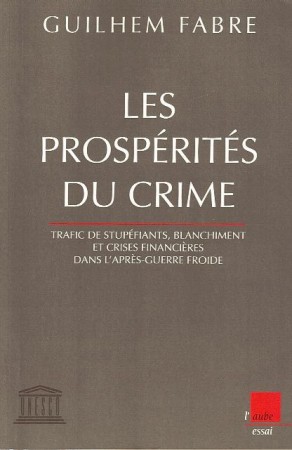
CRIMINAL PROSPERITY : DRUG TRAFFICKING, MONEY LAUNDERING
AND FINANCIAL CRISIS AFTER THE COLD WAR
(excerpts)
Guilhem Fabre[*]
UNESCO/Éditions de l’Aube, 1999
(to be published by Curzon Press, UK, 2002)[**]
|
|

CRIMINAL PROSPERITY : DRUG TRAFFICKING, MONEY LAUNDERING
AND FINANCIAL CRISIS AFTER THE COLD WAR
(excerpts)
Guilhem Fabre[*]
UNESCO/Éditions de l’Aube, 1999
(to be published by Curzon Press, UK, 2002)[**]
The corruption of the system which develops easily in the new context of commercial and financial globalisation, facilitates the formation of a true criminal economy, based on the use or the threatened use of violence, infiltrating governments at the provincial or even central levels.
As this economy grows and its benefits are recycled -a process of which the best known and most analysed aspect is the drug trade- they come to play a significant role in the multiple crisis of the international financial system. The author demonstrates this convincingly through the examples of Japan, Mexico, Thailand and Russia. His argument could be extended to the financial crisis which shook Argentina and Turkey in 2000-2001.
The uneventful slide from everyday corruption to a genuine
criminal economy, marginal in relation to the formal economy, but aggressive
and influential in political terms, creates a race, each stage of which
influences the very nature of the globalisation process.
I/ The mirror of history
Opium and colonization
II/ Drugs and post-communism: the Chinese Case
The rise of drugs trafficking and consumption in
China
The new drugs war
The expansion and diversification of drugs supplies
Yunnan : drugs and geo-politics in Sino-Burmese
relations
III/ The socio-economic stakes of drug trafficking
The laundering matter
The role of off-shore banking
IV/ Japan: the Yakuza recession
Lessons from the Japanese crisis
V/ Crisis and laundering in Mexico: from the "tequila effect" to the "cocaine effect"
VI/ Crisis and laundering in Thailand: the provincial godfathers' launch on Bangkok
Conclusion
The mirror of history, as seen in the first chapter through the example of the Middle Empire, and more generally that of Asia, projects the image of the incestuous ties knit between opium, colonial accumulation, and corruption. The end of the Cold War signals a market economy expansion at a planetary scale similar to that which prevailed before the World War I (1914-1918). This movement is accompanied by a comeback of illicit economy, drug trafficking, and corruption in emerging and transition countries. The Chinese example, developed in the second chapter, allows us to analyze the institutional, social and geopolitical issues tied to the resurgence of drugs in a country from which opium had been eliminated after the 1949 revolution.
The third chapter deals with the economic effects of the narcotics traffic, and more widely of organized crime, as of the money laundering issue. One of the essential paradoxes of drug policies relates to the fact that criminalization is enforced at the consumption level whereas money laundering ¾the center of gravity of the economic market¾ basically goes unpunished. Despite calls for decriminalization of consumption by numerous doctors and even Interpol General Secretary, Raymond Kendall, prisons are crammed with user-dealers who are to provide the future criminal work force in the USA. Thus, for example, two thirds of all inmates have serious drug abuse problems.
The clamor which is kept up regarding drug consumption contrasts with the relative silence surrounding the laundering of narcoproceeds. Although the pointers pile up, one after the other, through a series of judicial scandals involving highly-placed persons, including several heads of state, public opinion still does not clearly perceive the qualitative changes attained by “elite-level” delinquency. Not too long ago, robbing a bank was one of the most profitable crimes there was. Nowadays, however, it is far more profitable to get the money into the bank. The principal threat comes, not from the bank robber, but from the banker who is paid off to keep quiet regarding these transactions. In other words, corruption becomes the weapon used to commit the crime. The banking profession is fairly well respected and has an image which is far from the temptations to which it is a prey. It remains sheltered from the suspicions of a public opinion otherwise generously provided with anecdotic details regarding the mafia.. Extremely high earnings of globalized financial markets have accustomed many operators to wide profit margins which are hard to reach through actual production processes but which can be easily negotiated through laundering activities, which have a turnover of up to 25% or 30% on the monies invested.
Convergence of the licit, illicit and criminal spheres owes much to this financization dynamic and to the anonymity enjoyed by users of off-shore banking systems. Its effects, already being loosely studied by the IMF, are quite significant, as recounted in the pages of this book which tracks the ties between money laundering and financial stabilization in the Mexican, and later Thai and Japanese crises, which spilled over to all of Asia and the rest of the world. If organized crime’s best ally is the fear it inspires and the silence it maintains, the time has come to disclose the prosperities to which it resorts to build its economic and political expansion.
Introduction translated by María Mercedes Moreno, Mama Coca
Révo.cul dans la Chine pop. : Anthologie de la presse
des gardes rouges 1966-1967 (Editor), Paris, Editions 10/18, 1974.
Le nouveau conte d’hiver, by Yu Luojin, translated from the Chinese in collaboration with Huang San, Paris, Editions Christian Bourgois, 1982.
Conte de printemps, by Yu Luojin, translated from the Chinese in collaboration with Huang San, Paris, Editions Christian Bourgois, 1984.
Genèse du pouvoir et de l’opposition en Chine : le printemps de Yan’an, 1942, Paris, Editions L’Harmattan, 1990.
Le miroir chinois de la transition : Genèse d’une crise, 1989-2000,
Paris, Editions L’Harmattan, 2002.
| Mama Coca Home | Contra la Guerra Química y Biológica | Enlaces | Contáctenos |